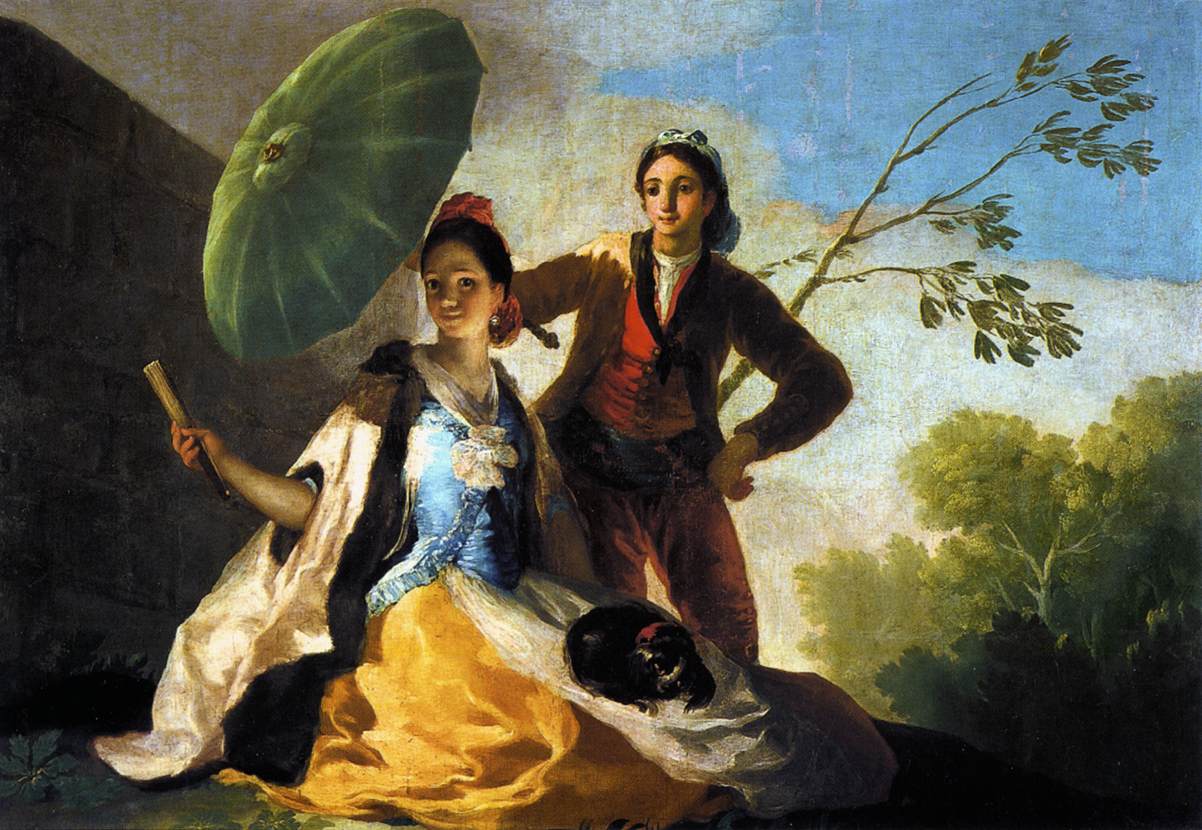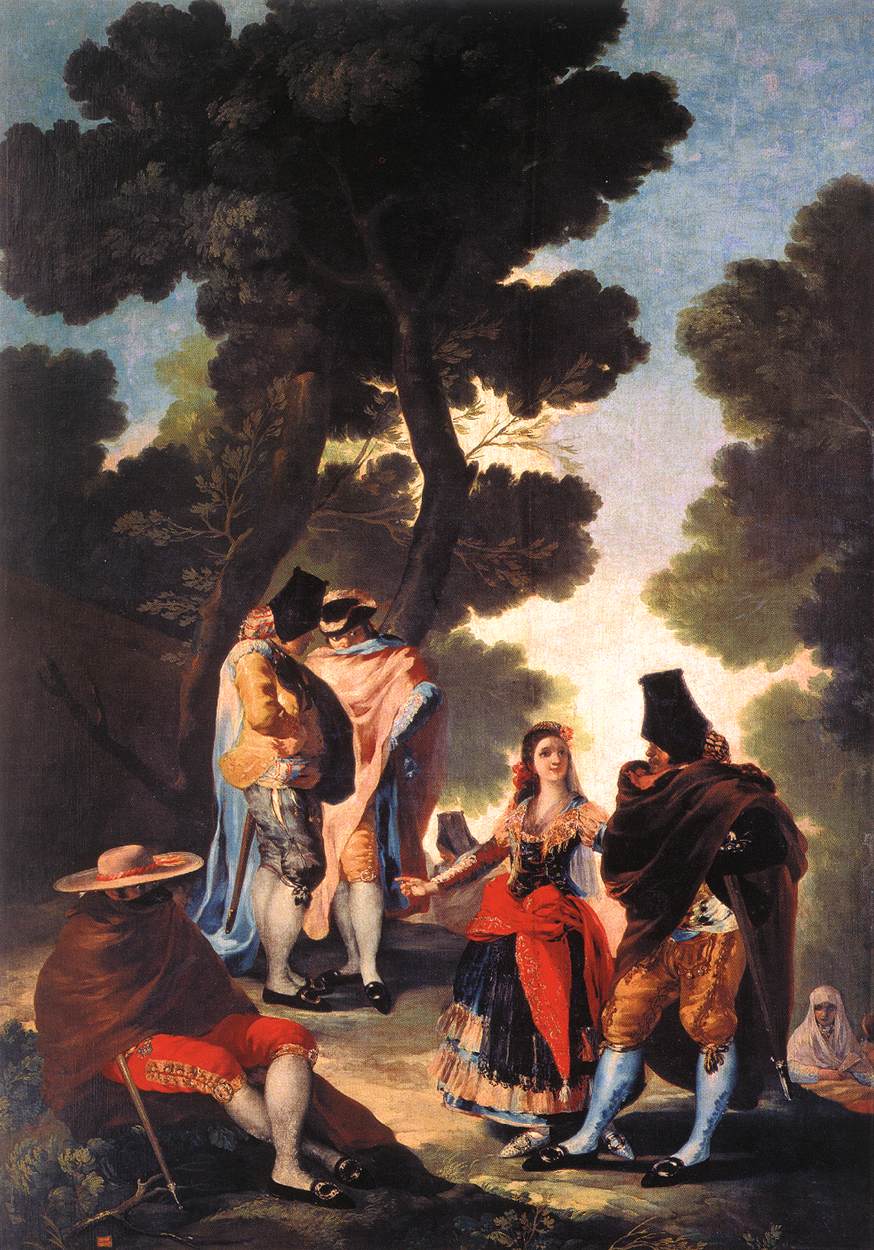(b. 1746, Fuendetodos, d. 1828, Bordeaux) by-Dr.Lal Ratnakar |
Biography Spanish painter (full name: Francisco José de Goya y Lucientes) and graphic artist. He was the most powerful and original European artist of his time, but his genius was slow in maturing and he was well into his thirties before he began producing work that set him apart from his contemporaries. Born at Fuendetodos in Aragon, the son of a gilder, he served his apprenticeship at Saragossa, then appears to have worked at Madrid for the court painter Francisco Bayeu. In about 1770 he went to Italy but he was back in Saragossa the next year. In 1773 he married Bayeu's sister, and by 1775 had settled at Madrid. Bayeu secured him employment making cartoons for the royal tapestry factory, and this took up most of his working time from 1775 to 1792. He made sixty-three cartoons (Prado, Madrid), the largest more than 6 m. wide. The subjects range from idyllic scenes to realistic incidents of everyday life, conceived throughout in a gay and romantic spirit and executed with Rococo decorative charm. During these years Goya also found time for portraits and religious works, and his status grew. He was elected to the Academy of San Fernando in 1780 and became assistant director of painting in 1785. In 1789 he was nominated a court painter to the new king, Charles IV. A more important turning-point in his career than any of these appointments, however, was the mysterious and traumatic illness he experienced in 1792. It left him stone deaf, and while convalescing in 1793 he painted a series of small pictures of 'fantasy and invention' in order, as he said, 'to occupy an imagination mortified by the contemplation of my sufferings'. This marks the beginning of his preoccupation with the morbid, bizarre, and menacing that was to be such a feature of his mature work. It was given vivid expression in the first of his great series of engravings, Los Caprichos (Caprices), issued in 1799. The set (executed c. 1793-98) consists of eighty-two plates in etching reinforced with aquatint, and their humour is constantly overshadowed by an element of nightmare. Technically revealing the influence of Rembrandt, they feature savagely satirical attacks on social customs and abuses of the Church, with elements of the macabre in scenes of witchcraft and diabolism. In 1795 Goya succeeded Bayeu as director of painting at the Academy of San Fernando and in 1799 he was appointed First Court Painter, producing his most famous portrait group, the Family of Charles IV (Prado), in the following year. The weaknesses of the royal family are revealed with unsparing realism, though evidently without deliberate satirical intent. Goya's early portraits had followed the manner of Mengs, but stimulated by the study of Velázquez's paintings in the royal collection he had developed a much more natural, lively, and personal style, showing increasing mastery of pose and expression, heightened by dramatic contrasts of light and shade. From about the same date as the royal group portrait are the celebrated pair of paintings the Clothed Maja and Naked Maja (Prado), whose erotic nature led Goya to besummoned before the Inquisition. Popular legend has it that they represent the Duchess of Alba, the beautiful widow whose relationship with Goya caused scandal in Madrid. Goya retained his appointment of court painter under Joseph Buonaparte during the French occupation of Spain (1808-14), but his activity as a painter of court and society decreased, and he was torn between his welcome for the regime as a liberal and his abhorrence as a patriot against foreign military rule. After the restoration of Ferdinand VII in 1814 Goya was exonerated from the charge of having 'accepted employment from the usurper' by claiming he had not worn the medal awarded him by the French, and he painted for the king the two famous scenes of the bloody uprising of the citizens of Madrid against the occupying forces - The Second of May, 1808 and The Third of May, 1808 (Prado). Equally dramatic, and even more savage and macabre, are the sixty-five etchings Los Desastres de la Guerra (The Disasters of War, 1810-14) - nightmare scenes, depicting atrocities committed by both French and Spanish. Goya virtually retired from public life after 1815, working for himself and friends. He kept the title of court painter but was superseded in royal favour by Vicente López. Towards the end of 1819 he fell seriously ill for the second time (a remarkable self-portrait in the Minneapolis Institute of Arts shows him with the doctor who nursed him). He had just bought a country house in the outskirts of Madrid, the Quinta del Sordo (House of the Deaf Man); and it was here after his recovery in 1820 that he executed fourteen large murals, sometimes known as the Black Paintings, now in the Prado. Painted almost entirely in blacks, greys, and browns, they depict horrific scenes, such as Saturn Devouring One of His Sons,executed with an almost ferocious intensity and freedom of handling. In 1824 Goya obtained permission from Ferdinand VII to leave the country for reasons of health and settled at Bordeaux. He made two brief visits to Spain, on the first of which (1826) he officially resigned as court painter. In these last years he took up the new medium of lithography (in his series the Bulls of Bordeaux), while his paintings illustrate his progress towards a style which foreshadowed that of the Impressionists. Goya completed some 500 oil paintings and murals, about 300 etchings and lithographs, and many hundreds of drawings. He was exceptionally versatile and his work expresses a very wide range of emotion. His technical freedom and originality likewise are remarkable — his frescoes in San Antonio de la Florida in Madrid (1798). for example, were evidently executed with sponges. In his own day he was chiefly celebrated for his portraits, of which he painted more than 200; but his fame now rests equally on his other work. |
1771-75-Oil on canvas, 58 x 44 cm-Private collection

1775-Oil on canvas, 290 x 226 cm-Museo del Prado, Madrid







कोई टिप्पणी नहीं:
एक टिप्पणी भेजें